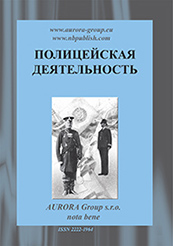The police and protection of human rights
Reference:
Yakovleva, E.O., Luneva , K.A., Tarikin , V.K. (2025). Prospects for the use of artificial intelligence in law enforcement. Police activity, 2, 114. https://doi.org/10.7256/2454-0692.2025.2.71931
Abstract:
The object of the research is the practical application of artificial intelligence. The authors noted that artificial intelligence has rapidly and firmly entered everyday life, forming a new field for interaction with the legal system. The subject of research is the legal acts, as well as a number of statistical indicators provided in official sources of the Ministry of Internal Affairs of Russia. The expansion of artificial intelligence capabilities has presented new challenges, in particular to criminal law, posing many tasks that require solutions and comprehensive scientific and legal analysis. One of these tasks, as cited by the authors, includes protecting the rights of citizens from the results of the negative use of artificial intelligence, as well as analyzing the effective possibilities of introducing artificial intelligence into the environment of relationships, systems and mechanisms in the investigation and disclosure of crimes. The main methods of the research conducted by the authors are: legal and dogmatic, structural and functional, analysis and systematization. The novelty of the research is the new areas of AI application that the authors have set as the task of the study. Special attention is paid to a number of issues about responsibility for actions committed by artificial intelligence, about determining the subject of a crime when using it, about the optimality and rational boundaries of its use in the investigation and disclosure of crimes by law enforcement agencies. The main conclusion of the study is the prospect of adapting modern criminal law to the rapid development of artificial intelligence, which depends on the degree of growth of scientific and technological progress in this area and requires a clear definition of potential risks and the development of effective law enforcement practice. These circumstances also point to the need for digitalization of law enforcement activities and the establishment of clear ethical principles in the creation and application of artificial intelligence.
Keywords:
qualification of crime, neural network, fraud, subject of crime, information technology, law enforcement, digitalization, crime, criminal law, artificial intelligence
The police and criminal procedure
Reference:
Pinchuk, L.V. (2025). The tasks of verifying evidence at the scene during the investigation of road traffic crimes. Police activity, 2, 1534. https://doi.org/10.7256/2454-0692.2025.2.73921
Abstract:
Subject of the study: patterns of collecting, examining, evaluating, and using evidence during the on-site investigation in the case of road traffic crimes. By identifying these patterns, the author emphasizes the practical importance of clarifying the objectives of on-site examination for the law enforcer, as it enables them to effectively plan and prepare for this investigative action in the investigation of this category of criminal cases. Special attention is given to possible investigative situations in which each of the examined objectives may be relevant to the law enforcer specifically in the investigation of road traffic crimes. The author analyzes literary sources to establish the most optimal list of objectives for this investigative action, refers to the criminal procedural legislation of Russia and the Commonwealth of Independent States (CIS), as well as to materials from judicial practice. The methodological basis of the study: method of critical analysis (examined the objectives of on-site examination highlighted by different authors), method of legal modeling (analysis of Article 194 of the Criminal Procedure Code of the Russian Federation), comparative legal method (analysis of criminal procedural legislation of CIS countries), and observation method (the author used official statistical data and examples from judicial practice). Scientific novelty of the research: the author examines the objectives of the on-site investigation of road traffic crimes at a monographic level in the absence of similar studies over the past twenty years. The author summarizes new material on the topic: official statistical data for 2023 and 2024, examples from judicial practice for 2024, as well as the author's experience in investigating road traffic crimes in the position of investigator. Main conclusions of the study: first, conclusions about highlighting specific objectives of the on-site investigation as a result of literature and criminal procedural legislation analysis, such as the objective of determining the details of the incident loci; second, conclusions about the author's formulations of some highlighted objectives, such as the search by the verified person for traces, items, and documents; third, a conclusion about the necessity of grouping all considered objectives based on their significance in the investigation of road traffic crimes and the current legislative regulation in the Criminal Procedure Code of the Russian Federation into primary and additional ones.
Keywords:
road traffic offences, criminal investigation, investigative actions, investigation of road traffic offences, verification of testimony, forensic tactics, forensic methodology, CPCs of the CIS states, tasks of verification testimony, road traffic accidents
Forensic activities and police work
Reference:
Syromiatnikov, K.A., Serbin, S.V., Vlezko, D.A. (2025). Countering Pre-investigation: Analysis of Systemic Issues and Recommendations. Police activity, 2, 3547. https://doi.org/10.7256/2454-0692.2025.2.73769
Abstract:
This scientific work conducts a comprehensive study of counteraction to preliminary investigations as a significant element of forensic science. The research thoroughly analyzes existing theoretical approaches and definitions of this phenomenon, highlighting its key characteristics and features in modern practice. A significant part of the study consists of developing an authors concept of understanding counteraction to preliminary investigations, taking into account current trends in the development of forensic science and law enforcement practice. A separate discussion deserves the systematic analysis of methodological and forensic support aimed at effectively identifying and overcoming obstructive activities when investigating various categories of crimes. The practical significance of the study is determined by the possibility of using the obtained results to improve the work of law enforcement agencies in the context of counteractive activities. The study lays a theoretical foundation for the further development of methods and techniques to counteract the obstruction of investigations, which contributes to enhancing the overall effectiveness of law enforcement activities. To address these tasks, it is necessary to systematize all existing forensic knowledge about counteraction to investigations, including practical tactical and methodological recommendations. The research is based on the dialectical method of scientific cognition, acting as a universal tool, as well as a set of cognitive methods: observation, analysis, generalization, and description, including systematic analysis. The scientific novelty of the study is determined by a comprehensive approach to the study of counteraction to preliminary investigations as a systemic phenomenon. The work presents a new definition of this concept for the first time, taking into account current trends in the development of forensic science and law enforcement practices. A significant innovation is the proposed original classification of forms of counteraction to investigations, based on a set of criteria that include the specifics of the counteracting subjects, the nature of the relationship between the subject and forensically significant information, as well as the nature of the actions (or inactions). For the first time, the study has identified and substantiated the structural content of counteraction to preliminary investigations, which includes subjects, goals and motivations, objects, time, place, context, methods, and techniques of counteraction. Based on the obtained data, a comprehensive set of practical recommendations for identifying and overcoming counteraction has been developed, becoming an important element of forensic methodologies for investigating specific types of crimes. A significant innovation is the identification of new directions in methodological and forensic support for law enforcement agencies in counteracting the obstruction of preliminary investigations.
Keywords:
methods, systematization, classification, forensic knowledge, methodological and forensic support of activities, forensics, investigative actions, system, counteraction to preliminary investigation, recommendation
Forensic activities and police work
Reference:
Petrosyan, M.A., Dulepina, O.V. (2025). Criminalistic aspects of the investigation of the murder of a newborn child by a mother committed in complicity. Police activity, 2, 4857. https://doi.org/10.7256/2454-0692.2025.2.73731
Abstract:
The methodology of investigating infanticide at the present stage of the development of criminology has a broad basis sufficient for the successful investigation of typical manifestations of this type of crime, presented by a number of monographs, dissertations and scientific articles. However, in practice, the investigator is faced with investigative situations that differ from the classical idea of the manifestations of crimes regulated by Article 106 of the Criminal Code of the Russian Federation. One of these is the commission of infanticide in complicity: the qualification of the act in this case will differ significantly, as well as the method of committing the crime, traces and other elements relevant to the investigation of the criminal case. Due to the fact that in situations involving complicity, the mother is often the actual instigator, the execution process is carried out by another entity. At the same time, the typical traces, place and method of infanticide change, and the existing forensic characteristics of the murder of a newborn child by a mother become inapplicable to the act. The listed factors substantiate the specifics of the research method. The methodological basis of this scientific work consists of a number of general scientific theoretical research methods, including analysis, induction, deduction, analogy, generalization, comparison and abstraction, as well as special sociological and psychological methods. The scientific novelty of this study is expressed in the development of a number of tactical and methodological recommendations that have a certain practical significance, since they are aimed at developing the investigation process in criminal cases related to both the murder of a newborn child by a mother in general and the specified act committed in complicity.
Keywords:
privileged types of murders, special subject, incitement, qualifications of infanticide, complicity, investigation methodology, murder of a newborn child, investigation of infanticide, interaction, checking investigative versions
Preventative work of the police
Reference:
Komarov, A.A. (2025). Historical variability of computer crime: the process of expanding the object and subject of criminal attacks and its structure. Police activity, 2, 5873. https://doi.org/10.7256/2454-0692.2025.2.73704
Abstract:
The object of research in this article is computer crime, and the subject is its historical variability, manifested in the expansion of objects of crimes, as well as in changes in the structure and motivation of criminals. The paper examines in detail key aspects of the topic, such as the influence of economic and technological factors on the evolution of computer crime, its territorial distribution and its connection with modern challenges, including digitalization and the transition to cashless payments. Special attention is paid to the analysis of victimological features of computer crimes, as well as problems of law enforcement practice and shortcomings in the investigation of complex cybercrimes. Unlike many works, this article focuses on a historical and materialistic approach, which allows for a deeper understanding of the relationship between economic changes and the transformation of crime. For the analysis, private research methods were used, including structural analysis, the trend method, the calculation of variance and coefficient of variation, as well as a comparative analysis of criminal statistics data and sample research materials (using the example of 759 criminal cases for 2022-2023). The research systematizes and ranks factors influencing the development of computer crime, such as changes in the economy transformation of communication technologies and shifts in mass consciousness. This allows us to better understand the mechanisms of crime adaptation to new conditions. The author explores in detail how over the past 30-40 years, the objects of crime have shifted from data and information systems to non-cash funds, cryptocurrencies and critical information infrastructure. This highlights the connection between crime and the digitalization of the economy. The author identifies differences between professional cybercrimes (targeting large sums and legal entities) and common fraud (targeting random victims). This allows us to develop more targeted prevention measures. The paper shows that the level of computer crime correlates with the level of digitalization of regions, which makes it possible to identify the most vulnerable territories and focus prevention efforts on them. The importance of data openness and interaction between the scientific community and law enforcement agencies to increase the effectiveness of the fight against crime was emphasized.
Keywords:
methodology, historical materialism, crime trends, Internet, internet fraud, crime statistics, crime rate, dinamic, cybercrime, criminology
Preventative work of the police
Reference:
Zyablova, A.G. (2025). The structure and content of the program for the prevention of antisocial behavior of minors based on the axiological approach. Police activity, 2, 7489. https://doi.org/10.7256/2454-0692.2025.2.73557
Abstract:
The subject of the research is the development, content and ways of implementing the program for the prevention of antisocial behavior of minors. This program is based on the axiological approach, includes the formation of value attitudes, methodological recommendations and a thematic plan. Its goal is to form and develop stable prosocial value attitudes and corresponding behavior models in minors. The program is designed to work with minors aged 14 to 18. This program includes diagnostics of value attitudes, formation of moral guidelines, development of social skills and prevention of antisocial behavior. Implementation of the program for the prevention of antisocial behavior helps to reduce the level of antisocial behavior, strengthen moral and ethical standards and improve social adaptation of minors. The program can be useful for teachers, psychologists, social workers and other specialists involved in the prevention of antisocial behavior among minors. The main research methods are the methods of designing and modeling activities, methods of analyzing and synthesizing theoretical data, pedagogical experiment, questionnaires, observation, analysis of the results of program implementation. The novelty of the study lies in the development of a program for the prevention of antisocial behavior in minors based on the axiological approach. The axiological approach used involves focusing on the formation of a system of value attitudes in minors that contribute to the prevention of antisocial behavior. The program includes a unique thematic plan aimed at the formation of specific value attitudes, as well as methodological recommendations for subjects performing pedagogical functions in the implementation of the developed program. The theoretical significance lies in substantiating the effectiveness of the axiological approach as a means of preventing antisocial behavior. This program can be recommended for implementation in educational institutions, social services and other organizations working with minors.
Keywords:
formation of value attitudes, prosocial behavior, preventive measures, methodological recommendations, pedagogical prevention, prevention program, the axiological approach, value orientations, minors, antisocial behavior
The police and issues in the fight against corruption
Reference:
Komarov, A.A. (2025). The responsibility of corrupt officials and the prevention of criminal law. Police activity, 2, 90104. https://doi.org/10.7256/2454-0692.2025.2.70893
Abstract:
The subject of the research in the presented article is the criminal law norms that determine the penalization of corruption-related crimes. The issues of sufficiency and effectiveness of sanctions of criminal law norms, their preventive potential, the difference in law enforcement practice in terms of sentencing corrupt officials and ordinary criminals are actively discussed. The issue of compliance of the norms on criminal liability for corruption and the criminological realities of our time is raised. The author examines such aspects of the topic as the influence of the structure of corruption-related crimes on the law enforcement practice of courts, the specifics of criminal proceedings at the judicial and pre-trial stages that affect the sentencing of corrupt officials. The practice of applying additional punishment in the form of deprivation of the right to hold certain positions or engage in certain activities, as well as such a measure of a criminal nature as confiscation, is statistically analyzed.The methodological basis of the research is the dialectical method of cognition. The private scientific methods are the summary and grouping of the actual data of criminal statistics, mathematical methods for calculating relative crime rates. The author's special contribution to the study of this problem is the following patterns revealed in the course of the study: three-year cycles of "recruiting the mass of defendants" in corruption-related cases; an indication of certain aspects of the expanded reproduction of corruption-related crimes based on bribery; differences in the types of punishments imposed on corrupt officials and ordinary criminals; deprivation of the right to hold certain positions or engage in certain activities and confiscation as preventive measures (sanctions) of the criminal law, contributing to the private prevention of offending corrupt behavior; the result of an analysis of the effectiveness of the application of additional punishment in the form of deprivation of a special right (disqualification) in relation to corrupt officials; the result of an analysis of the effectiveness of the confiscation of corrupt officials; arguments are given regarding the appropriateness of applying a judicial fine to corrupt officials.
Keywords:
criminal statistics, crime trends, crime rates, punishment for corrupt officials, corruption crime, bribery, criminal penalty, corruption, criminal law, criminology
 This work is licensed under a Creative Commons Attribution-NonCommercial 4.0 International License.
This work is licensed under a Creative Commons Attribution-NonCommercial 4.0 International License.









 © 1998 2025 Nota Bene. Publishing Technologies. NB-Media Ltd.
© 1998 2025 Nota Bene. Publishing Technologies. NB-Media Ltd.




